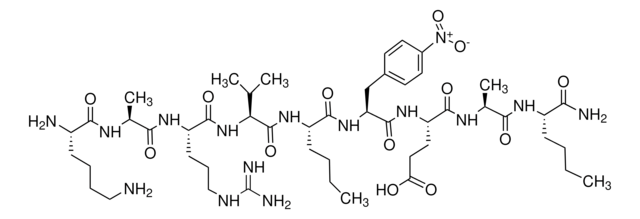MAK255
Cysteine Assay Kit (Fluorometric)
sufficient for 100 fluorometric tests
Synonym(s):
Cysteine Quantitation Kit
Sign Into View Organizational & Contract Pricing
All Photos(1)
About This Item
UNSPSC Code:
12161503
NACRES:
NA.84
Recommended Products
detection method
fluorometric
relevant disease(s)
cardiovascular diseases
storage temp.
−20°C
General description
Cysteine (CYS) is a non-essential, sulfur containing amino acid in humans, related to cystine. Cysteine is important for protein synthesis, detoxification, and diverse metabolic functions. It is found in beta-keratin, which comprises the main protein in nails, skin, and hair. Cysteine is also important in collagen production, as well as skin elasticity and texture. A component of the antioxidant, glutathione, cysteine plays a role in the metabolism of essential biochemicals such as coenzyme A, heparin, and biotin. An elevated level of total cysteine can predict cardiovascular disease and metabolic syndromes. Cysteine deficiency is known to be one of the consequences of aging.
Features and Benefits
Compatible with high-throughput handling systems.
Suitability
Suitable for the detection of cysteine in serum, plasma, and other biological fluids.
Principle
The Cysteine Assay Kit detects the physiological concentration of cysteine in a variety of biological fluids. The assay is based on the cleavage of thiol group of reduced cysteine generating a fluorometric product (ex = 365 nm/ em = 450 nm), directly proportional to the amount of total cysteine in the sample. The assay is specific and other thiol-based amino acids do not interfere with the assay. This high-throughput adaptable assay kit is simple and sensitive enough to detect to 10 µM of cysteine in a variety of samples.
Storage Class Code
10 - Combustible liquids
Flash Point(F)
188.6 °F - closed cup
Flash Point(C)
87 °C - closed cup
Certificates of Analysis (COA)
Search for Certificates of Analysis (COA) by entering the products Lot/Batch Number. Lot and Batch Numbers can be found on a product’s label following the words ‘Lot’ or ‘Batch’.
Already Own This Product?
Find documentation for the products that you have recently purchased in the Document Library.
Kazuki Hayashima et al.
The Journal of biological chemistry, 298(3), 101703-101703 (2022-02-13)
Ferroptosis is an iron-dependent mode of cell death caused by excessive oxidative damage to lipids. Lipid peroxidation is normally suppressed by glutathione peroxidase 4, which requires reduced glutathione. Cystine is a major resource for glutathione synthesis, especially in cancer cells.
Oxidative stress and ageing: is ageing a cysteine deficiency syndrome?
Droge W.
Philosophical transactions of the Royal Society of London. Series B, Biological sciences, 360(1464), 2355-2372 (2005)
Virender Kumar Pal et al.
eLife, 10 (2021-11-19)
A fundamental challenge in human immunodeficiency virus (HIV) eradication is to understand how the virus establishes latency, maintains stable cellular reservoirs, and promotes rebound upon interruption of antiretroviral therapy (ART). Here, we discovered an unexpected role of the ubiquitous gasotransmitter
Xinbo Wang et al.
Cancer research, 81(20), 5217-5229 (2021-08-14)
Ferroptosis is a lipid peroxidation-dependent cell death caused by metabolic dysfunction. Ferroptosis-associated enzymes are promising therapeutic targets for cancer treatment. However, such therapeutic strategies show limited efficacy due to drug resistance and other largely unknown underlying mechanisms. Here we report
Our team of scientists has experience in all areas of research including Life Science, Material Science, Chemical Synthesis, Chromatography, Analytical and many others.
Contact Technical Service


